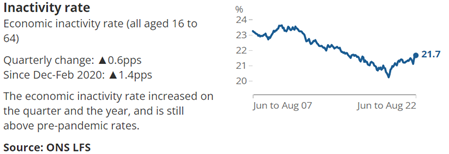
Record numbers not looking for work due to long-term illness
Date: Thursday 13 October 2022
The number of people not looking for work because they are suffering from a long-term illness has hit a record high, latest official figures show.
The economic inactivity rate increased by 0.6 percentage points to 21.7% in June to August 2022, compared with the previous quarter (March to May 2022), which had a notably lower economic inactivity rate than other periods. This increase in the latest quarter was largely driven by those aged 50 to 64 years and those aged 16 to 24 years. Looking at economic inactivity by reason, the quarterly increase was driven by people inactive because they are long-term sick or because they are students. Numbers of those economically inactive because they are long-term sick increased to a record high.
In July to September 2022, the estimated number of vacancies fell by 46,000 on the quarter to 1,246,000, this is the largest fall on the quarter since June to August 2020. Despite three consecutive quarterly falls, the number of vacancies remain at historically high levels.
The number of job vacancies fell again, although the level still remains high with many firms struggling to recruit.
ONS head of labour market and household statistics David Freeman said the number of people neither working nor looking for work had continued to rise over the past few months.
The economic inactivity rate - which measures the proportion of people aged between 16 and 64 not looking for work - increased to 21.7% in the June to August period, the ONS said. The number of those inactive because they are long-term sick hit a record high of nearly 2.5 million.

Mr Freeman added:
"While the number of job vacancies remains high after its long period of rapid growth, it has now dropped back a little, with a number of employers telling us they've reduced recruitment due to a variety of economic pressures."

The estimated number of vacancies in the three months to September fell by 46,000 to 1,246,000, the largest fall since mid-2020 during the Covid pandemic.
